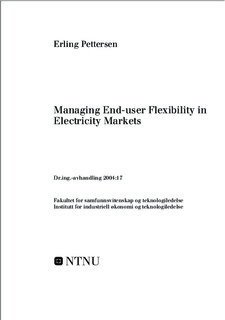| dc.contributor.author | Pettersen, Erling | nb_NO |
| dc.date.accessioned | 2014-12-19T14:26:54Z | |
| dc.date.available | 2014-12-19T14:26:54Z | |
| dc.date.created | 2004-04-16 | nb_NO |
| dc.date.issued | 2004 | nb_NO |
| dc.identifier | 125078 | nb_NO |
| dc.identifier.isbn | 82-471-6236-9 | nb_NO |
| dc.identifier.uri | http://hdl.handle.net/11250/265635 | |
| dc.description.abstract | Over the past couple of decades, electricity markets across the world have been deregulated. When the electricity systems were being developed, governments exercised extensive control over the industry to ensure reliable services. Today, most of the basic investments have been carried out, and more and more countries have chosen to let market mechanisms regulate the electricity systems. Different countries have, however, approached the deregulation in different ways. While production of electricity is subject to competition in all deregulated markets, there are differences as to how the wholesale markets and end-user markets are organized. An overview of energy optimization models dealing with uncertainty in both regulated and deregulated electricity markets is found in [5].
The primary focus of this thesis is to analyze how participants in the Norwegian electricity market would behave in a situation where the consumers are metered and charged by the hour. The thesis includes five papers, preceded by an introduction. The current part provides a background for the papers and puts them into a common framework. Another purpose of the background part is to point out the scientific contributions of the thesis, which, as we shall see, primarily lie in the application of known methods to new problems.
In Section 2 of the background part a description of the Norwegian electricity market is provided. The section starts with a very brief overview of when and why the market was opened up for competition. Next, we give a description of the wholesale market, with some emphasis on the regulating market (Section 2.1). The end-user market is the primary subject of this thesis, and an overview of this market is given in Section 2.2. Today Norwegian end-users are normally not metered and charged by the hour, as will be apparent from Section 2.2, but if they were, it is likely that this would induce more short-term flexibility in the end-user market. In Section 3 we give a brief overview of how hourly metering, coupled with some sort of two-way communication, may help achieve this. Also, we discuss some potential effects of such flexibility for consumers, retailers, network operators, environment and society (Section 3.2). Finally, in Section 4, we look at two alternative ways of making the end-users alter their load profiles, and discuss pros and cons of the two solutions. Each paper includes its own introduction, and for an overview of the contents of the papers, we refer to these. | nb_NO |
| dc.language | eng | nb_NO |
| dc.publisher | Fakultet for samfunnsvitenskap og teknologiledelse | nb_NO |
| dc.relation.ispartofseries | Doktoravhandlinger ved NTNU, 1503-8181; 2004:17 | nb_NO |
| dc.relation.haspart | Pettersen, Erling; Philpott, Andy; Wallace, Stein W.. An Electricity Market Game between Consumers, Retailers and Network Operators. Decision Support Systems. 40(3-4): 427-438, 2005. | nb_NO |
| dc.relation.haspart | Philpott, Andy; Pettersen, Erling. Optimizing demand-side bids in day-ahead electricity markets. IEEE Transactions on Power Systems. 21(2): 488-498, 2006. | nb_NO |
| dc.relation.haspart | Fleten, Stein-Erik; Pettersen, Erling. Constructing bidding curves for a price-taking retailer in the Norwegian electricity market. IEEE Transactions on Power Systems. 20(2): 701-708, 2005. | nb_NO |
| dc.subject | Economics | en_GB |
| dc.subject | SOCIAL SCIENCES: Business and economics: Economics | en_GB |
| dc.title | Managing End-user Flexibility in Electricity Markets | nb_NO |
| dc.type | Doctoral thesis | nb_NO |
| dc.source.pagenumber | 190 | nb_NO |
| dc.contributor.department | Norges teknisk-naturvitenskapelige universitet, Fakultet for samfunnsvitenskap og teknologiledelse, Institutt for industriell økonomi og teknologiledelse | nb_NO |
| dc.description.degree | dr.ing. | nb_NO |
| dc.description.degree | dr.ing. | en_GB |
